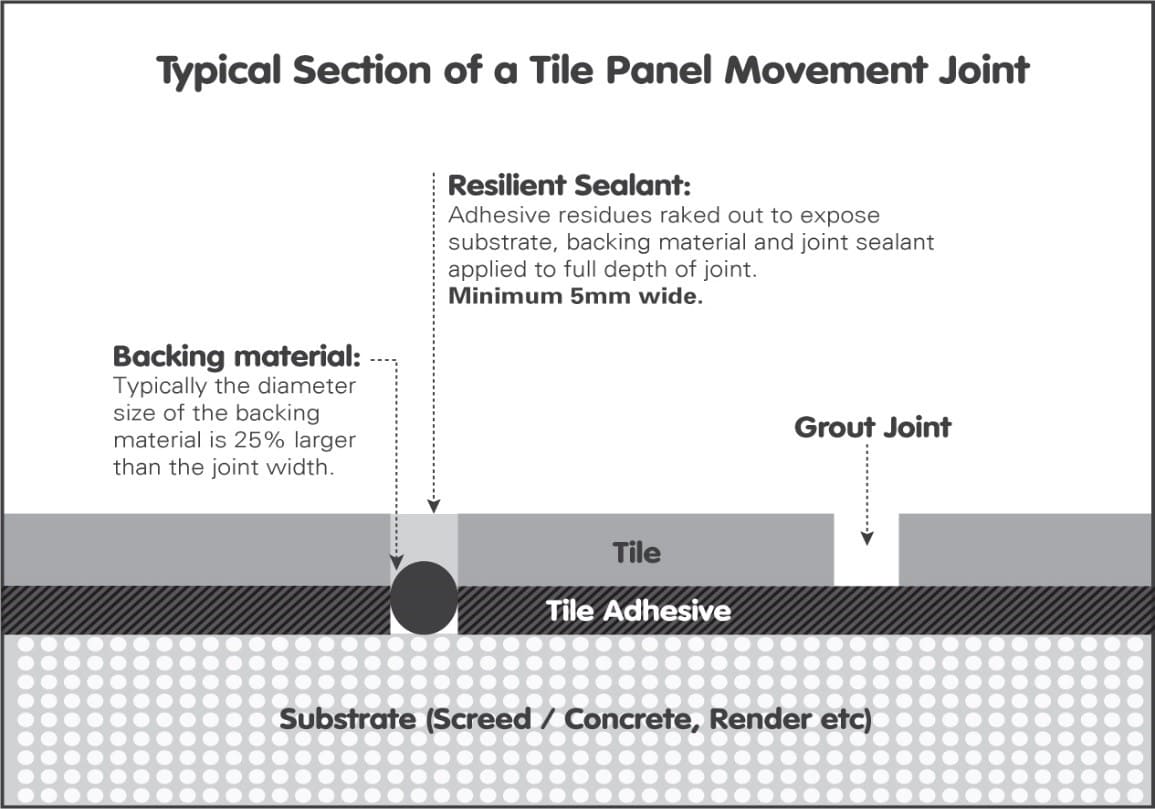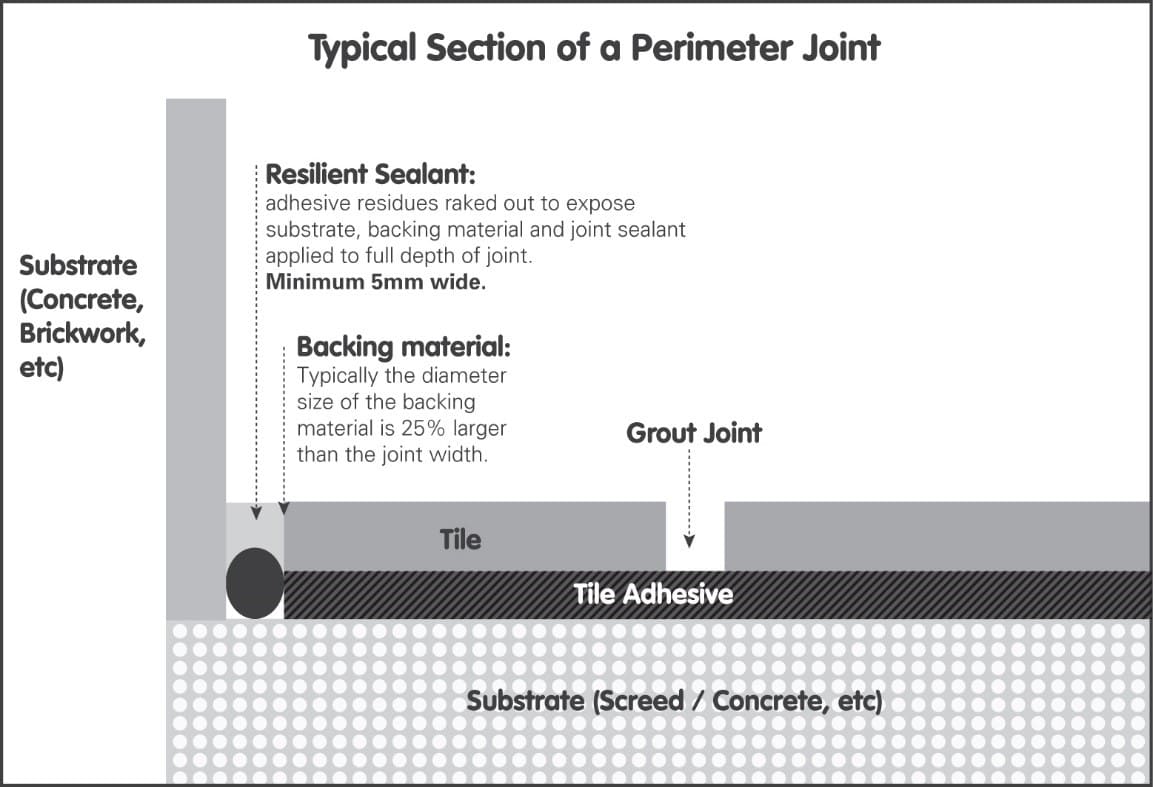General specification for fixing glazed ceramic floor tiles or porcelain tiles onto a suspended wooden floor
Please note that ‘general’ specifications are issued for information purposes, and should not be used as project specifications.
As each and every project needs to be assessed individually on its own merits and characteristics please contact the TAL Technical Advice Centre for a project-specific detailed materials and methods specification for specific projects.
It is important that the tile selected is suitable for the application, preferably against a written Supplier’s specification. Factors such as water absorption, irreversible moisture expansion, MOR and PEI ratings, chemical resistance and overall stability of the product need to meet the requirements of the service conditions.
The backs of all tiles must be clean and free from dust and contaminants.
Please note that any “wet” areas, such as showers or balconies, should be waterproofed using TAL SUPERFLEX I or TAL SUREPROOF waterproofing compounds prior to commencing tiling. Please feel free to contact us for a specification for waterproofing and tiling these areas, as well as for technical literature on any of our products.
TAL PRODUCT REQUIREMENTS
The TAL products required for this installation are as follows:
TAL SEALMASTER CORD
Special note must be taken of the following:
Suspended Wooden Floors:
The following is an extract from SANS 10107 : 2011, Code of Practice for the Design & Installation for Ceramic Tiling:
"An important consideration with this type of background is that the sheets or boards shall be adequately braced to provide a rigid surface, free from any springiness and surface undulations. They shall also not undergo any distortion during and after completion of the tiling."
Wood exhibits various types of movement, making it one of the most difficult substrates on which to tile. Latex modified adhesives will allow for lateral and horizontal movement in the floor, but the tile itself remains a rigid material and excessive vertical deflection movement in the background could result in an installation failure, ie tiles cracking or coming loose, or both.
Only exterior grade board should be used externally or in ‘wet’ applications.
Adhesive System:
We have specified the use of TAL GOLDSTAR 6 rapid setting high strength adhesive for the installation of these tiles. However, if timing on this project allows for a quick setting adhesive option, then TAL GOLDSTAR 12 can be considered.
The advantages of using TAL GOLDSTAR 12 are as follows :
- TAL GOLDSTAR 12 has a longer pot life (pot life of 4 hours, grout after 6 – 8 hours, and traffic after 12 hours)
- TAL GOLDSTAR 12 is more cost effective than TAL GOLDSTAR 6
It is however important that newly installed tiles are protected from traffic (other trades, etc.) for a minimum of 12 hours, while the adhesive sets. This is especially important in fast-track installations.
Tile Panel Movement Joints & Perimeter Joints:
It should be noted that the lack of movement joints in a tile panel, or poorly constructed joints, is a major cause of tile failure. Joints must be created at the required spacing and must be well raked out to remove all traces of adhesive residues, debris, contamination, etc, ie the joint must extend through the tile and tile adhesive layers. These joints must be filled with TAL GOLDSTAR SEALMASTER 1000 Polyurethane Joint Sealant (and suitable backing cord where applicable) in accordance with the manufacturer’s instructions.
(See later detail of correctly constructed tile panel movement joint and perimeter joint.)
- BACKGROUND PREPARATION
- Suspended wooden floors must be in good condition and must be thoroughly braced at maximum 300mm in each direction (screwed, not nailed), and must be sanded down to remove all traces of existing polishes, varnishes, coatings or sealants. The wooden surface must be clean, dry, firm and sound and free from dust, loose particles and all traces of surface contaminants.
- New installations should be left for at least 24 hours to reach ambient temperatures before tiling to minimize the risk of warping. Ensure there is adequate under-floor ventilation below wood composite floors to prevent rot once the wooden surface is sealed and tiled.
- The wooden surface must be sealed (front back and sides) with a coat of TAL SUPERPRIME, which is applied by brush or roller.
- THE TAL SUPERPRIME APPLICATION MUST BE ALLOWED TO CURE FOR APPROXIMATELY 6 HOURS, DEPENDING ON AMBIENT CONDITIONS, BUT MUST NOT BE LEFT FOR MORE THAN 30 HOURS. TILING MAY COMMENCE EARLIER THAN 6 HOURS PROVIDED THE SUPERPRIME APPLICATION IS DRY AND THERE IS NO VISIBLE TRANSFER WHEN WIPED OR RUBBED.
- Key the surface with a slurry consisting of 1 part TAL KEYCOAT to 2 parts TAL KEYMIX powder or 2 parts TAL GOLDSTAR 6 or 12 powder (by volume), which is applied by block brush. Allow this slurry coat to dry for 4 – 6 hours before applying the adhesive.
- ADHESIVE SYSTEM
- Apply TAL GOLDSTAR 6 rapid-setting adhesive mixed 20kg with 5 litres of TAL BOND (replacing the water in the mix) to the background using a notched trowel.
Alternatively, TAL BOND POWDER may be added to the adhesive mixing water at a ratio of 1 x 1kg sachet per 20kg TAL GOLDSTAR 6, or TAL GOLDFLEX single-part flexible rapid-setting adhesive may be used. When using TAL GOLDFLEX no additives are required, simply mix with clean water, alleviating possible mixing errors on site. - In this tiling situation it is imperative that there is a solid bed of adhesive at least 6mm thick beneath each tile . We would recommend the use of a NOTCHED FLOOR TROWEL.
- At no time spread more adhesive than can be tiled onto in 10 – 15 minutes. Depending on atmospheric conditions, this will normally be around one square metre. This prevents the adhesive from drying or “skinning” before the tiles are applied.
- Bed dry tiles (do not soak) firmly into the wet adhesive with a twisting action to ensure full contact between the background, tiles and adhesive. Tiles should be well tapped home with a rubber mallet or the wooden handle of a trowel. It is sound practice to remove the occasional tile to ensure that good contact has been achieved.
- When using heavily lugged tiles, or tiles with a very irregular back profile, it is good practice to butter the back of each tile, ensuring that the grooves or dovetails are completely filled with adhesive.
- Clean off any surplus adhesive remaining on the face of the tiles and between the joints with a damp sponge before the adhesive dries.
- Never butt-joint tiles. Joints are required to allow the individual tiles to move with respect to each other and thus avoid a compressive stress build-up. They are also required as vents for the tile adhesive to cure. The joints between ceramic floor tiles must be a minimum of 5mm wide, and a minimum of 3mm wide between porcelain tiles.
- Pot life of the adhesive will vary with climatic conditions. Under no circumstances should adhesive which has been left standing for too long be reconstituted by adding more liquid.
- Do not tile over structural, expansion or cold joints in the background. These joints must be extended through the various layers to the surface.
- Apply TAL GOLDSTAR 6 rapid-setting adhesive mixed 20kg with 5 litres of TAL BOND (replacing the water in the mix) to the background using a notched trowel.
- GROUTING
-
-
-
- Grouting must not be carried out until sufficient bond has developed between the bedding mix and the tiles to preclude disturbance of the tiles during the grouting operation. Allow a minimum of 4 hours before grouting.
- Use grey or coloured TAL WALL & FLOOR GROUT mixed 20kg with 6 litres of TAL BOND (replacing the water in the mix) for filling tile joints up to 8mm wide.
Alternatively, TAL BOND POWDER may be added to the grout mixing water, at a ratio of 1 x 1kg sachet per 20kg TAL WALL & FLOOR GROUT. - WARNING :
- Particular care must be taken to clean the grout off the tile face before it hardens completely. This is especially important when an additive such as TAL BOND or TAL BOND POWDER has been used.
- A sample of the tiles to be used should be tested beforehand to ensure that no grout is absorbed through the glaze, or into the tile body, causing permanent staining of the tiles.
- It is important to use the stipulated amount of liquid in the TAL Grout mixture. When cleaning, a damp, not wet , sponge must be used. Over hydration (too much water) of the mix, or in cleaning, causes colour variations in the grout joints, and also affects the integrity of the grout, resulting in a friable product.
-
-
-
-
- MOVEMENT JOINTS
- It should be noted that the lack of movement joints in a tile panel is a major cause of tile failure. They should be specified at the design stage to avoid placing them in heavy traffic areas and spoiling the visual effect of the tiles.
- Movement joints should be located in both directions at maximum 3 metre centres for this application.
- Movement joints should also be located around the perimeter of all floors, in all vertical corners, against obstructions fixed to the structural background and over all discontinuities in building materials, e.g. at interfaces of concrete and wooden panels, concrete and brickwork, etc. In addition, movement joints should be located around any fixtures protruding through the tiled surface such as columns or stairs.
- The joints should be at least 5mm wide and extend through the adhesive and tile layers. All construction / cold joints and structural joints in the background must be extended through the adhesive and tile layers to the surface in the form of tile panel movement joints. With regards to structural joints, the full width of the structural joints must be respected and extended through the adhesive and tile layers to the surface.
- Where practical, the bulk of the depth of the movement joint can be filled with TAL SEALMASTER CORD.
- Seal the joint using TAL GOLDSTAR SEALMASTER 1000 polyurethane joint sealant in accordance with the manufacturer’s instructions. It is important that the joint sealant bonds only to the sides of the movement joint.
- For the key requirements common to all tiling situations please refer to SANS 10107-2011, Code of Practice for the Design and Installation of Ceramic Tiling.
NOTE : This installation must be allowed to set sufficiently before being trafficked.


Should you require any further assistance or have any queries regarding the above, please do not hesitate to contact us. Assuring you of our best attention at all times.
Yours faithfully,
SHARON MARGON
TECHNICAL ADVICE SUPERVISOR
© TAL 1972 & 1984
- MOVEMENT JOINTS
-